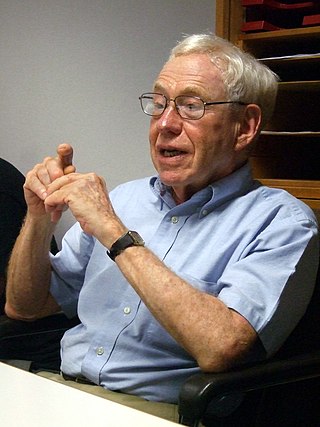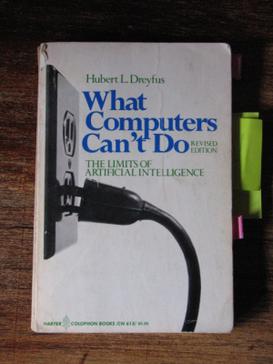Related Research Articles
Artificial intelligence (AI) is intelligence demonstrated by machines, as opposed to intelligence of humans and other animals. Example tasks in which this is done include speech recognition, computer vision, translation between (natural) languages, as well as other mappings of inputs.

Cognitive science is the interdisciplinary, scientific study of the mind and its processes with input from linguistics, psychology, neuroscience, philosophy, computer science/artificial intelligence, and anthropology. It examines the nature, the tasks, and the functions of cognition. Cognitive scientists study intelligence and behavior, with a focus on how nervous systems represent, process, and transform information. Mental faculties of concern to cognitive scientists include language, perception, memory, attention, reasoning, and emotion; to understand these faculties, cognitive scientists borrow from fields such as linguistics, psychology, artificial intelligence, philosophy, neuroscience, and anthropology. The typical analysis of cognitive science spans many levels of organization, from learning and decision to logic and planning; from neural circuitry to modular brain organization. One of the fundamental concepts of cognitive science is that "thinking can best be understood in terms of representational structures in the mind and computational procedures that operate on those structures."
Non-cognitivism is the meta-ethical view that ethical sentences do not express propositions and thus cannot be true or false. A noncognitivist denies the cognitivist claim that "moral judgments are capable of being objectively true, because they describe some feature of the world". If moral statements cannot be true, and if one cannot know something that is not true, noncognitivism implies that moral knowledge is impossible.
Phenomenology is the philosophical study of the structures of experience and consciousness. As a philosophical movement it was founded in the early years of the 20th century by Edmund Husserl and was later expanded upon by a circle of his followers at the universities of Göttingen and Munich in Germany. It then spread to France, the United States, and elsewhere, often in contexts far removed from Husserl's early work.

Cognition refers to "the mental action or process of acquiring knowledge and understanding through thought, experience, and the senses". It encompasses all aspects of intellectual functions and processes such as: perception, attention, thought, intelligence, the formation of knowledge, memory and working memory, judgment and evaluation, reasoning and computation, problem solving and decision making, comprehension and production of language. Imagination is also a cognitive process, it is considered as such because it involves thinking about possibilities. Cognitive processes use existing knowledge and discover new knowledge.

In psychology, cognitivism is a theoretical framework for understanding the mind that gained credence in the 1950s. The movement was a response to behaviorism, which cognitivists said neglected to explain cognition. Cognitive psychology derived its name from the Latin cognoscere, referring to knowing and information, thus cognitive psychology is an information-processing psychology derived in part from earlier traditions of the investigation of thought and problem solving.
In artificial intelligence, symbolic artificial intelligence is the term for the collection of all methods in artificial intelligence research that are based on high-level symbolic (human-readable) representations of problems, logic and search. Symbolic AI used tools such as logic programming, production rules, semantic nets and frames, and it developed applications such as knowledge-based systems, symbolic mathematics, automated theorem provers, ontologies, the semantic web, and automated planning and scheduling systems. The Symbolic AI paradigm led to seminal ideas in search, symbolic programming languages, agents, multi-agent systems, the semantic web, and the strengths and limitations of formal knowledge and reasoning systems.
Neat and scruffy are two contrasting approaches to artificial intelligence (AI) research. The distinction was made in the 70s and was a subject of discussion until the middle 80s. In the 1990s and 21st century AI research adopted "neat" approaches almost exclusively and these have proven to be the most successful.

Hubert Lederer Dreyfus was an American philosopher and professor of philosophy at the University of California, Berkeley. His main interests included phenomenology, existentialism and the philosophy of both psychology and literature, as well as the philosophical implications of artificial intelligence. He was widely known for his exegesis of Martin Heidegger, which critics labeled "Dreydegger".
Situated cognition is a theory that posits that knowing is inseparable from doing by arguing that all knowledge is situated in activity bound to social, cultural and physical contexts.
Post-cognitivist psychology comprises varieties of psychology that have emerged since the 1990s, challenging the basic assumptions of cognitivism and information processing models of cognition, and forms one of the fields contributing to the postcognitivism movement. Important predecessors of these movements include critical psychology and humanistic psychology.
Computational cognition is the study of the computational basis of learning and inference by mathematical modeling, computer simulation, and behavioral experiments. In psychology, it is an approach which develops computational models based on experimental results. It seeks to understand the basis behind the human method of processing of information. Early on computational cognitive scientists sought to bring back and create a scientific form of Brentano's psychology.
A physical symbol system takes physical patterns (symbols), combining them into structures (expressions) and manipulating them to produce new expressions.

The history of artificial intelligence (AI) began in antiquity, with myths, stories and rumors of artificial beings endowed with intelligence or consciousness by master craftsmen. The seeds of modern AI were planted by philosophers who attempted to describe the process of human thinking as the mechanical manipulation of symbols.This work culminated in the invention of the programmable digital computer in the 1940s, a machine based on the abstract essence of mathematical reasoning. This device and the ideas behind it inspired a handful of scientists to begin seriously discussing the possibility of building an electronic brain.
The philosophy of artificial intelligence is a branch of the philosophy of technology that explores artificial intelligence and its implications for knowledge and understanding of intelligence, ethics, consciousness, epistemology, and free will. Furthermore, the technology is concerned with the creation of artificial animals or artificial people so the discipline is of considerable interest to philosophers. These factors contributed to the emergence of the philosophy of artificial intelligence. Some scholars argue that the AI community's dismissal of philosophy is detrimental.
Enactivism is a position in cognitive science that argues that cognition arises through a dynamic interaction between an acting organism and its environment. It claims that the environment of an organism is brought about, or enacted, by the active exercise of that organism's sensorimotor processes. "The key point, then, is that the species brings forth and specifies its own domain of problems ...this domain does not exist "out there" in an environment that acts as a landing pad for organisms that somehow drop or parachute into the world. Instead, living beings and their environments stand in relation to each other through mutual specification or codetermination" (p. 198). "Organisms do not passively receive information from their environments, which they then translate into internal representations. Natural cognitive systems...participate in the generation of meaning ...engaging in transformational and not merely informational interactions: they enact a world." These authors suggest that the increasing emphasis upon enactive terminology presages a new era in thinking about cognitive science. How the actions involved in enactivism relate to age-old questions about free will remains a topic of active debate.
Embodied embedded cognition (EEC) is a philosophical theoretical position in cognitive science, closely related to situated cognition, embodied cognition, embodied cognitive science and dynamical systems theory. The theory states that intelligent behaviour emerges from the interplay between brain, body and world. The world is not just the 'play-ground' on which the brain is acting. Rather, brain, body and world are equally important factors in the explanation of how particular intelligent behaviours come about in practice.

Hubert Dreyfus was a critic of artificial intelligence research. In a series of papers and books, including Alchemy and AI (1965), What Computers Can't Do and Mind over Machine (1986), he presented a pessimistic assessment of AI's progress and a critique of the philosophical foundations of the field. Dreyfus' objections are discussed in most introductions to the philosophy of artificial intelligence, including Russell & Norvig (2003), the standard AI textbook, and in Fearn (2007), a survey of contemporary philosophy.
This is a timeline of artificial intelligence, sometimes alternatively called synthetic intelligence.
Logic Theorist is a computer program written in 1956 by Allen Newell, Herbert A. Simon, and Cliff Shaw. It was the first program deliberately engineered to perform automated reasoning, and has been described as "the first artificial intelligence program". Logic Theorist proved 38 of the first 52 theorems in Whitehead and Russell's Principia Mathematica, and for some theorems even found new and more elegant proofs.
References
- Costall, A. and Still, A. (eds) (1987) Cognitive Psychology in Question. Brighton: Harvester Press Ltd.
- Costall, A. and Still, A. (eds) (1991) Against Cognitivism: Alternative Foundations for Cognitive Psychology. New York: Harvester Wheatsheaf.
- Potter, J. (2000). "Post cognitivist psychology", Theory and Psychology, 10, 31–37.
- Stahl, G. (2015). The group as paradigmatic unit of analysis: The contested relationship of CSCL to the learning sciences. In M. Evans, M. Packer & K. Sawyer (Eds.), The learning sciences: Mapping the terrain. Cambridge, UK: Cambridge University Press. Web: http://GerryStahl.net/pub/ls.pdf.
- Wallace, B., Ross, A., Davies, J.B., and Anderson, T. (2007) The Mind, The Body and the World: Psychology After Cognitivism. London: Imprint Academic.
- Witt, J. K. (2011). "Action's Effect on Perception", Current Directions in Psychological Sciences, 20,201-206.
- Zielke, B. (2004) Kognition und soziale Praxis: Der Soziale Konstruktionismus und die Perspektiven einer postkognitivistischen Psychologie. Bielefeld: transcript.